
adolf martinez soler/Shutterstock
JDM engines have long attracted car enthusiasts and gearheads worldwide. And why not? They have creative and clever designs, are reliable, and really pack a punch if you know what engines to get and how to squeeze that performance out of them. You already know the major players when it comes to JDM engines, including Toyota, Nissan, Honda, Suzuki, and Mazda. Engines that come from these manufacturers, in particular, have a unique appeal. They are often connected with both street racing culture and polished engineering.
While several JDM engines are recognized and praised for their designs and factory specs, there is an alternate story regarding the unrealized potential of many of these powertrains. This «hidden» horsepower is the primary reason they remain massive favorites among tuning enthusiasts and modders. This is also one reason why there are JDM engines out there that have way more power than we think — JDM engines tend to be super adaptable to changes. The engineering principles used in designing these engines can allow for large increases in power output with very simple tuning and aftermarket mods.
Another reason is that the power of some JDM engines is often overshadowed by other reputations — some get pigeonholed into being the most reliable JDM engines ever built, or the most affordable, most economical, best JDM engines for project cars, and so on. Whatever the reason may be, here are six engines that we think have more than meets the eye when it comes to power.
Toyota 2JZ-GTE
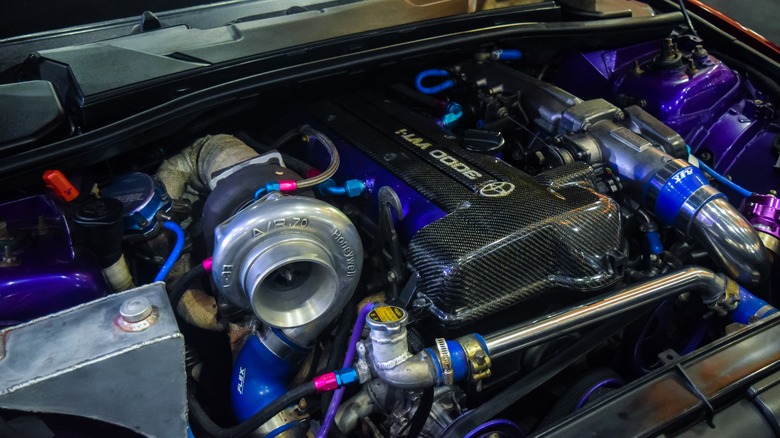
Rakhmat Darmawan/Shutterstock
A large percentage of you who read the title would have immediately pictured a Toyota Supra MK IV — that’s how iconic this engine has become. In fact, one can even argue that the engine itself might be more popular than the Supra now, especially considering the other Toyota models powered by the legendary 2JZ engine. This is one turbocharged inline-6 that has had a huge impact on car culture, like with the 2001 «The Fast and the Furious» movie.
The engine debuted in the early 1990s and gained a reputation for its construction and tuning capability. But it’s power that we are really interested in: Initially rated at 320 horsepower and 315 pound-feet of torque in North American markets, the engine was part of Japan’s «Gentlemen’s Agreement» to cap horsepower, which unofficially limited it to 276 horsepower domestically. But staying true to «JDM engines that have way more power than you think,» there’s a lot of horsepower that wrenchers and DIY mechanics can squeeze out of this engine. Some 2JZ engines have been customized to produce more than 2,000 horsepower.
The 2JZ-GTE’s architecture includes a twin-turbo arrangement that uses a sequential turbo system to maximize power delivery over the engine speed range. This means that the engine has a faster response at low speeds while delivering a significant boost at higher revs. Despite being discontinued in the early 2000s, the 2JZ-GTE is still a highly sought after engine even to date.
Nissan RB26DETT
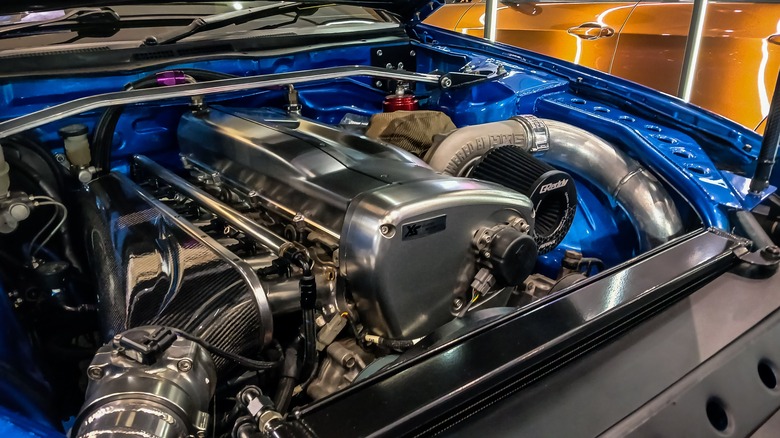
Rakhmat Darmawan/Shutterstock
Developed in the late 1980s and produced until 2002, this engine powered the JDM favorites like the R32, R33, and R34 Nissan Skyline GT-R models. The nickname «Godzilla» for the Skyline cars tells a lot about the engine, too. Like with the 2JZ, the basic output of the RB26 was 276 horsepower and 260 pound-feet of torque because of the gentleman’s agreement.
Not bad, since cars powered by this engine could accelerate from 0-60 mph in just over five seconds, and reach top speeds of over 150 mph. But again, like the 2JZ, it only takes some minor modifications to really exceed these limits. Even some basic tuning can bring the engine to 300 horsepower. With more significant mods, enthusiasts have been able to boost the engine’s output well above 1,000 horsepower.
The RB26DETT has a 2.6-liter engine with a cast-iron block and an aluminum head, four valves per cylinder, dual overhead camshafts, and two turbochargers. This is an arrangement for remarkable power figures, for sure, but it also provided toughness that made it one of the most reliable inline-6 engines ever built. So, the RB26DETT is still a popular choice for engine swaps and tuning projects thanks to this rugged build and massive aftermarket support.
This engine’s racing history is well documented, as well. The Skyline GT-R allowed Nissan to dominate the Japanese Touring Car Championship and more — makes you wonder if this really is the best engine ever put in a Nissan Skyline.
Subaru EJ22

FernandoV/Shutterstock
This 2.2-liter four-cylinder boxer engine, manufactured between 1990 and 2001, is well-known as one of the most reliable JDM engines ever built. The EJ22’s flat-four layout has a natural balance, which decreases vibrations when compared to traditional inline-4 engines. This design helps the engine last longer, and improves the driving experience by making it more steady and responsive at the same time. The engine block and head are made of aluminum alloy, and the cylinders are coated with cast iron. Later versions of the naturally aspirated EJ22 had molybdenum-coated pistons, which decreased weight and friction, increasing the engine’s life.
So, yes, the EJ22 has a lot to show for as a reliable engine. It’s this reliability, though, that kind of overshadows the engine’s power, and qualifies it as a JDM engine that has way more power than one would think. The turbocharged versions of the EJ22, like the one used in the famous Subaru Impreza 22B, are especially underrated when it comes to power. These versions produce up to 280 horsepower stock (as opposed to the 135 horsepower on the naturally aspirated variant) and 268 pound-feet of torque, and include innovations like a closed-deck construction and oil sprayers for the forged pistons for high-performance output.
Besides the reliability and power, the EJ22 is also easy to maintain. The engine’s non-interference design makes sure that if the timing belt fails, there is no risk of piston-valve collision, which can be a common costly repair in interference engines.
Toyota 1LR-GUE
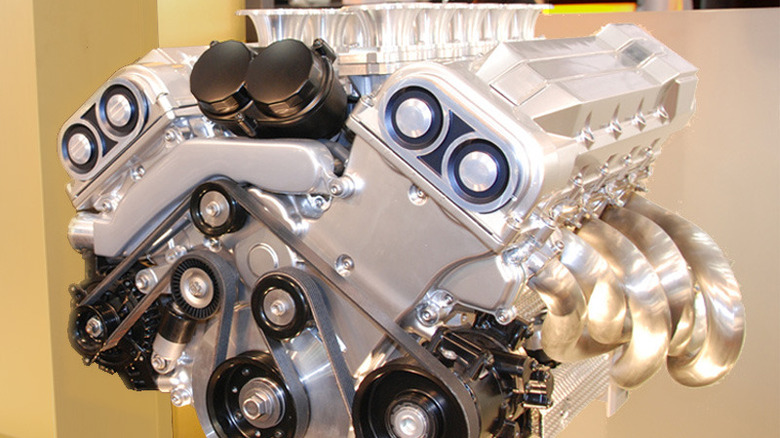
Wikimedia Commons
The Toyota 1LR-GUE, a 4.8-liter naturally aspirated V10 engine, developed in the early 2000s, is kind of lesser known quantity compared to other engines here — but no less powerful. This engine produces an impressive 552 horsepower and 354 pound-feet of torque — case in point, the Lexus LFA can accelerate from 0-60 mph in just 3.7 seconds, and reach a top speed of 202 mph. The 1LR is more than just sheer power, though; it has a compact design that keeps the dimensions of a V8 while weighing less than a standard V6. This translates to improved performance because of the better balance and less overall bulk.
It was built using lightweight materials, has a 72-degree angle between cylinder banks for better balance, and titanium alloy connecting rods and forged pistons to handle the high 12:1 compression ratio. This engine’s architecture allows for a 9,000 rpm redline, thanks to its 10 individually operated throttle bodies — unusual for an engine in a non-race car.
Interestingly, only 500 copies of this engine were built between December 2010 and December 2012, all housed within the Lexus LFA. Even more interestingly, the 1LR-GUE’s sound (or sonic signature, to feel fancy), is a big part of the engine’s appeal, and it was developed in partnership with Yamaha. Because of some unique design elements, like a custom surge tank and dual exhaust systems, it almost sounds like a Formula One car.
[Featured image by Altair78 via Wikimedia Commons | Cropped and scaled | CC BY 2.0]
Mazda 13B-REW
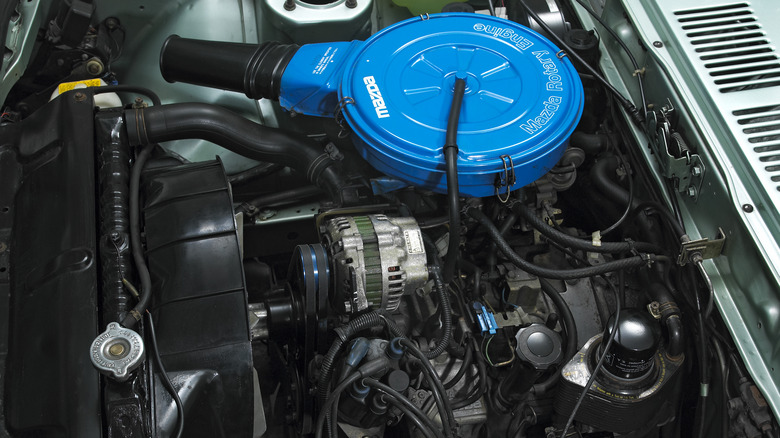
Heritage Images/Getty Images
This engine represents the peak of Mazda’s long-standing dedication to rotary engineering — beginning in 1975, and culminating with the 13B-REW variant launched in 1992. It was designed specifically for the Mazda FD RX-7, and helped the car in achieving a precise 50: 50 weight distribution — that’s where the sports car’s famous handling and balance comes from.
It is a twin-rotary Wankel engine with a displacement of 1,302cc, and there are many reasons that made the Mazda 13B Rotary engine so special. First off, its architecture allowed for a small design that was lightweight, weighing only 327 pounds. With a sequential twin-turbo configuration, the engine produced a smooth power curve and an impressive power density of up to 212 horsepower per liter. Initially, it produced between 255 and 276 horsepower, with torque varying from 217 to 231 pound-feet.
This engine powered the famous Mazda RX-7 and later the RX-8 — some might even say that it ushered in an era in sports car history. What’s surprising is that the 13B-REW is still in production today, built to order at Mazda’s factory by a dedicated staff. Even though Mazda no longer builds new cars with rotary engines, each engine is built by a single engineer, which says a lot about the devotion to precision and quality. But even with these achievements and devotions, the 13B-REW was often criticized for its reliability issues.
Toyota 2UR-GSE
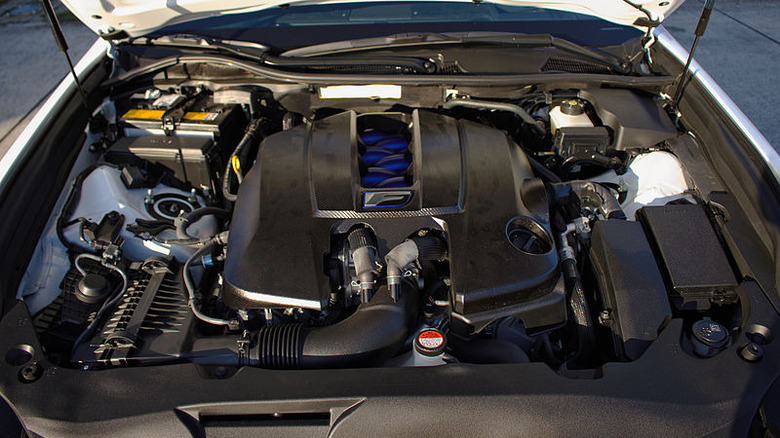
Wikimedia Commons
Save for a few exceptions like the 2JZ, Toyota engines are mostly known for their economy. So, it must’ve been a pleasant surprise at the time when Toyota deviated from the norm and introduced its 2UR-GSE engine, a powerful naturally aspirated V8. This engine found itself inside Toyota’s luxury subsidiary Lexus, powering vehicles such as the IS-F, RC-F, LC500, and IS500 F-Sport Performance since its development in 2007.
This V8 engine is fairly powerful, with a displacement of 4,969cc — but still more powerful than you expect it to be. It has a DOHC valvetrain and an aluminum build, while producing 416 to 477 horsepower, with torques ranging from 371 to 399 pound-feet. One unique feature is its use of both multi-port and direct fuel injection to improve performance.
On the road, the 2UR-GSE’s power translates to some impressive performance results. Thanks to this engine, the Lexus RC F can accelerate from 0-60 mph in 4.2 seconds, while the somewhat heavier IS 500 F Sport Performance does it in 4.4 seconds. Although its top speed of 149 mph is not something to write home about, it still strikes a balance with a respectable combined fuel efficiency of 20 MPG — quite efficient for its power class.
The 2UR-GSE is also known for its dependability, being able to travel over 200,000 miles with few problems. Maintenance costs are reasonably low, too, showing that luxury and great performance do not have to sacrifice reliability.
[Featured image by Kickaffe (Mario von Berg) via Wikimedia Commons | Cropped and scaled | CC BY-SA 4.0]